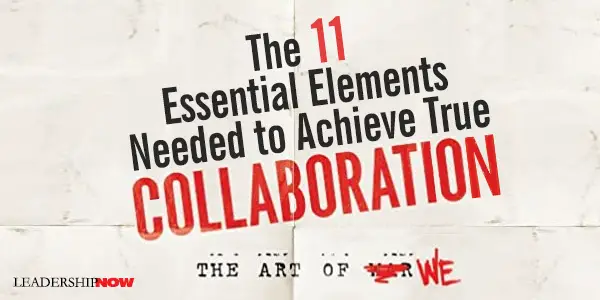 |
 |
03.12.12

The 11 Essential Elements Needed to Achieve True Collaboration
DAN SANKER states that ironically, in order to remain “competitive” companies will have to become more collaborative. Collaborate: The Art of We is a practical guide to going beyond democratic or cooperative work to creating truly collaborative work environments as a growth strategy. Collaboration is not a new concept, but globalization and new technologies have turned it into one of the best methods of competitive advantage available. Rather than engaging in an endless tug-of-war over the dwindling crumbs in a finite market, collaborative companies find ways to make the pie bigger, or create whole new pies, expanding everyone’s market and revenue. “It’s not about how many people you can defeat, but rather about how many people you can help win.” Although networking, coordination, and cooperation may look like collaboration, they are not. True collaboration is the “synergistic relationship formed when two or more entities working together produce something much greater than the sum of their individual abilities and contributions.” It results in something that did not exist before. The focus is on results and not process. Collaboration is distinct from cooperation in that “although both cooperating parties may achieve a common goal, they do not necessarily enhance each other’s capacity. In addition, cooperating parties do not fully share risks, responsibilities, and rewards. In the case of collaboration, all available resources, as well as risks, responsibilities, and rewards, are fully shared.” For a collaboration to be successful, Sanker says that eleven elements must come together: Ongoing Communication. People need to be able to talk to one another freely and regularly. Groups that do not have this kind of interaction are nothing more than loose collections of individuals working on their own tasks, toward their own ends. Willing Participation. Everyone believes that they are working toward the same, mutually beneficial goal and that each one of them will have gained something valuable when that goal has been achieved. Brainstorming. It’s the creative part of the collaboration process, in which members of the group move beyond the “same kind of thinking” to come up with new ideas that bring true value to the collaborative effort. Teamwork. It’s teamwork that keeps people with a diverse set of skills, knowledge, information, and perspectives working together effectively and efficiently to achieve their common goal. A Common Purpose. If the group moves forward too quickly without taking the time to clarify their goal and make sure that everyone is in agreement about what it is, they will undoubtedly run into huge disagreements that are likely to tear the effort apart. Trust. You need to feel confident that other people in the group are putting the group’s shared goal—not their own interests—first, and that they will keep confidential or sensitive information within the group, take you seriously, respect your point of view, and not take credit for your ideas. A Plan for Achieving the Goal. Everyone needs to be working from the same script, clearly understanding roles and responsibilities, and they need to have the same understanding of what success looks like. A Diverse Group. Diversity is the power behind collaboration. Without diversity groupthink sets in. It is diversity that gives a team the unique perspectives needed to create truly innovative solutions. Mutual Respect. For collaboration to be successful, team members must encourage, listen to, and seriously consider all of the ideas suggested by others in the group, no matter how unworkable they might seem. A Written Agreement. A written agreement helps the group avoid misunderstandings and lack of clarity that could derail the process after everyone has invested a great deal of time, effort, and resources. Effective Leadership. Whether one person has been formally designated as the leader of the group is self-led, leadership of some sort is essential to keep the group focused on its destination and facilitating the process of getting there. 
Posted by Michael McKinney at 11:33 PM
|
BUILD YOUR KNOWLEDGE
 

How to Do Your Start-Up Right STRAIGHT TALK FOR START-UPS 
Grow Your Leadership Skills NEW AND UPCOMING LEADERSHIP BOOKS 
Leadership Minute BITE-SIZE CONCEPTS YOU CAN CHEW ON 
Classic Leadership Books BOOKS TO READ BEFORE YOU LEAD |